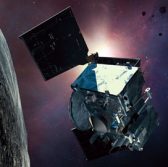 A Lockheed Martin-built spacecraft is scheduled for liftoff on Sept. 8 from Cape Canaveral, Florida aboard a United Launch Alliance rocket as part of a NASA mission to survey a near-Earth asteroid and return a sample back home.
A Lockheed Martin-built spacecraft is scheduled for liftoff on Sept. 8 from Cape Canaveral, Florida aboard a United Launch Alliance rocket as part of a NASA mission to survey a near-Earth asteroid and return a sample back home.
Lockheed said the University of Arizona will lead the space agency’s seven-year Origins, Spectral Interpretation, Resource Identification, Security-Regolith Explorer mission that aims to explore Bennu and look for clues about how life began on Earth.
“Along with the key scientific findings, with this mission, we’ll obtain data associated with how to operate a spacecraft around a planetary body the size of Bennu,” said Richard Kuhns, Lockheed OSIRIS-REx program manager.
Lockheed expects OSIRIS-REx to orbit the sun for a year after the spacecraft’s launch and subsequently receive a boost from Earth’s gravity in September 2017 to reach Bennu’s pace.
The spacecraft will work to survey Bennu for two years then collect a sample by July 2020 through a “touch-and-go” maneuver without landing on the asteroid, Lockheed noted.
The company added OSIRIS-REx will near Earth on Sept. 24, 2023 and send the sample return capsule on a direct course to a certain location in Utah.
Scientists from NASA’s Johnson Space Center in Houston will retrieve the sample in efforts to collect information on the origin of the solar system, according to the company.
Bennu was discovered in 1999 and the 1,614-foot asteroid crosses Earth’s orbit around the sun every six years.




